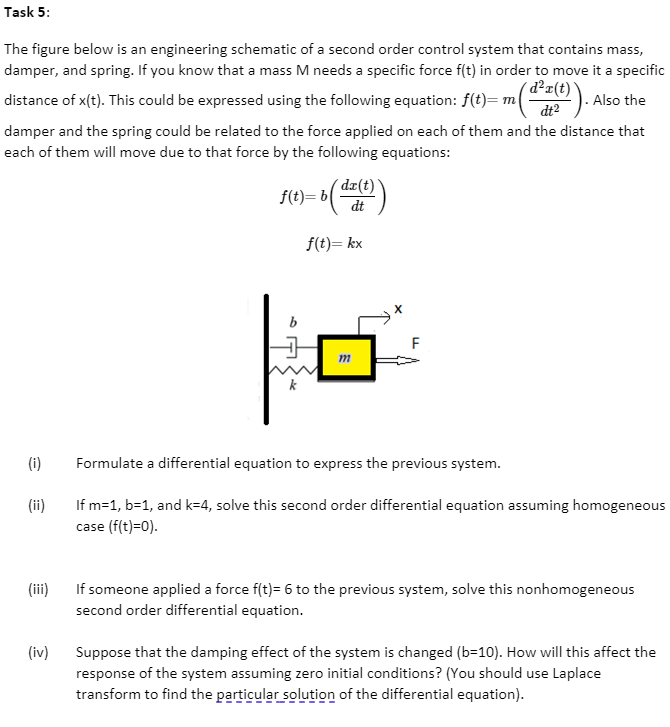Task 5: The figure below is an engineering schematic of a second order control system that contains mass, damper, and spring. If you know that a mass M needs a specific force f(t) in order to move it a specific distance of x(t). This could be expressed using the following equation: f(t)= m( ). ´d²r(t) Also the dt2 damper and the spring could be related to the force applied on each of them and the distance that each of them will move due to that force by the following equations: dz(t) f(t)= b dt f(t)= kx F m k (i) Formulate a differential equation to express the previous system. (ii) If m=1, b=1, and k=4, solve this second order differential equation assuming homogeneous case (f(t)=0). (iii) If someone applied a force f(t)= 6 to the previous system, solve this nonhomogeneous second order differential equation. (iv) Suppose that the damping effect of the system is changed (b=10). How will this affect the response of the system assuming zero initial conditions? (You should use Laplace transform to find the particular solution of the differential equation).
Task 5: The figure below is an engineering schematic of a second order control system that contains mass, damper, and spring. If you know that a mass M needs a specific force f(t) in order to move it a specific distance of x(t). This could be expressed using the following equation: f(t)= m( ). ´d²r(t) Also the dt2 damper and the spring could be related to the force applied on each of them and the distance that each of them will move due to that force by the following equations: dz(t) f(t)= b dt f(t)= kx F m k (i) Formulate a differential equation to express the previous system. (ii) If m=1, b=1, and k=4, solve this second order differential equation assuming homogeneous case (f(t)=0). (iii) If someone applied a force f(t)= 6 to the previous system, solve this nonhomogeneous second order differential equation. (iv) Suppose that the damping effect of the system is changed (b=10). How will this affect the response of the system assuming zero initial conditions? (You should use Laplace transform to find the particular solution of the differential equation).
Functions and Change: A Modeling Approach to College Algebra (MindTap Course List)
6th Edition
ISBN:9781337111348
Author:Bruce Crauder, Benny Evans, Alan Noell
Publisher:Bruce Crauder, Benny Evans, Alan Noell
Chapter5: A Survey Of Other Common Functions
Section5.2: Power Functions
Problem 17E: Tsunami Waves and BreakwatersThis is a continuation of Exercise 16. Breakwaters affect wave height...
Related questions
Question

Transcribed Image Text:Task 5:
The figure below is an engineering schematic of a second order control system that contains mass,
damper, and spring. If you know that a mass M needs a specific force f(t) in order to move it a specific
distance of x(t). This could be expressed using the following equation: f(t)= m( ).
´d²r(t)
Also the
dt2
damper and the spring could be related to the force applied on each of them and the distance that
each of them will move due to that force by the following equations:
dz(t)
f(t)= b
dt
f(t)= kx
F
m
k
(i)
Formulate a differential equation to express the previous system.
(ii)
If m=1, b=1, and k=4, solve this second order differential equation assuming homogeneous
case (f(t)=0).
(iii)
If someone applied a force f(t)= 6 to the previous system, solve this nonhomogeneous
second order differential equation.
(iv)
Suppose that the damping effect of the system is changed (b=10). How will this affect the
response of the system assuming zero initial conditions? (You should use Laplace
transform to find the particular solution of the differential equation).
Expert Solution
This question has been solved!
Explore an expertly crafted, step-by-step solution for a thorough understanding of key concepts.
Step by step
Solved in 4 steps with 4 images

Recommended textbooks for you

Functions and Change: A Modeling Approach to Coll…
Algebra
ISBN:
9781337111348
Author:
Bruce Crauder, Benny Evans, Alan Noell
Publisher:
Cengage Learning

Functions and Change: A Modeling Approach to Coll…
Algebra
ISBN:
9781337111348
Author:
Bruce Crauder, Benny Evans, Alan Noell
Publisher:
Cengage Learning